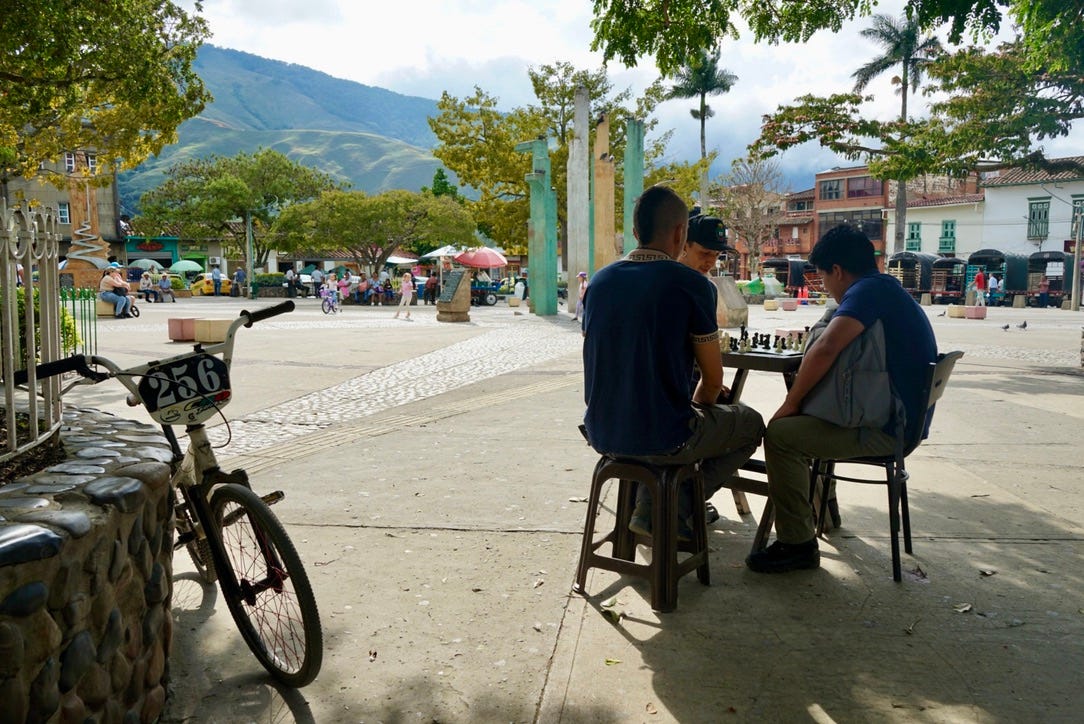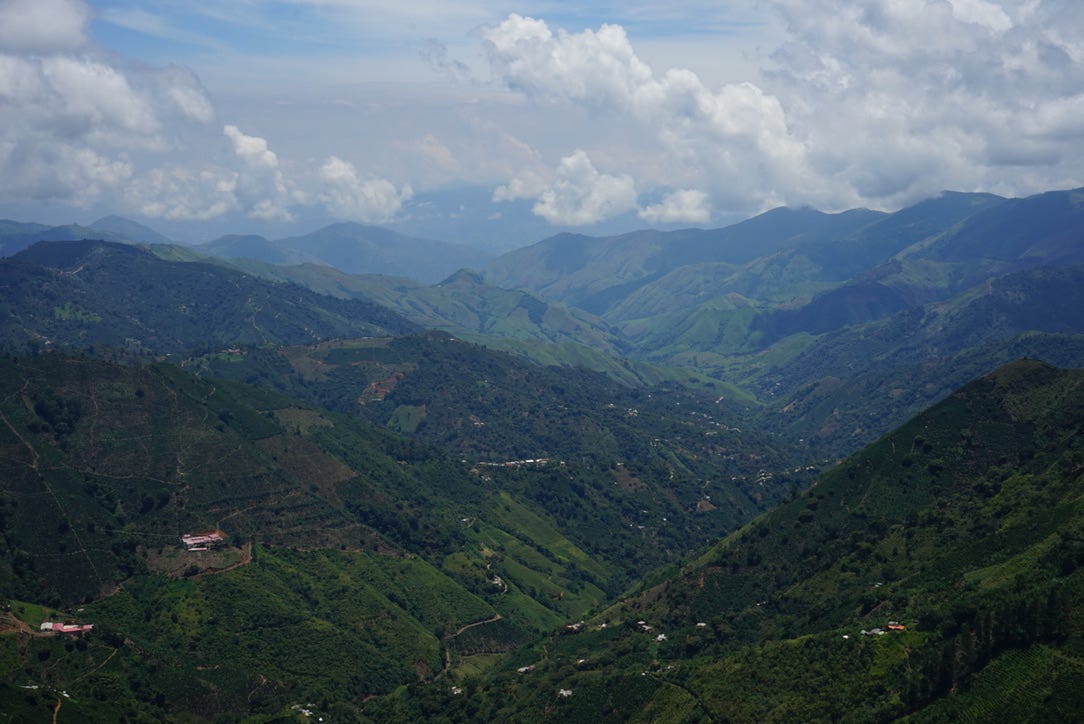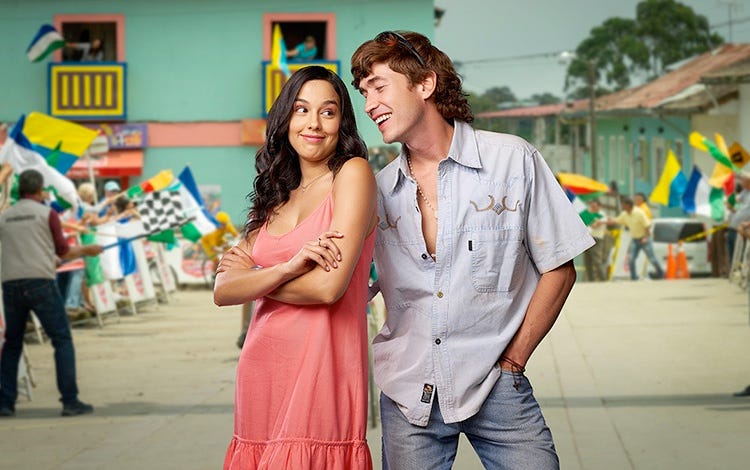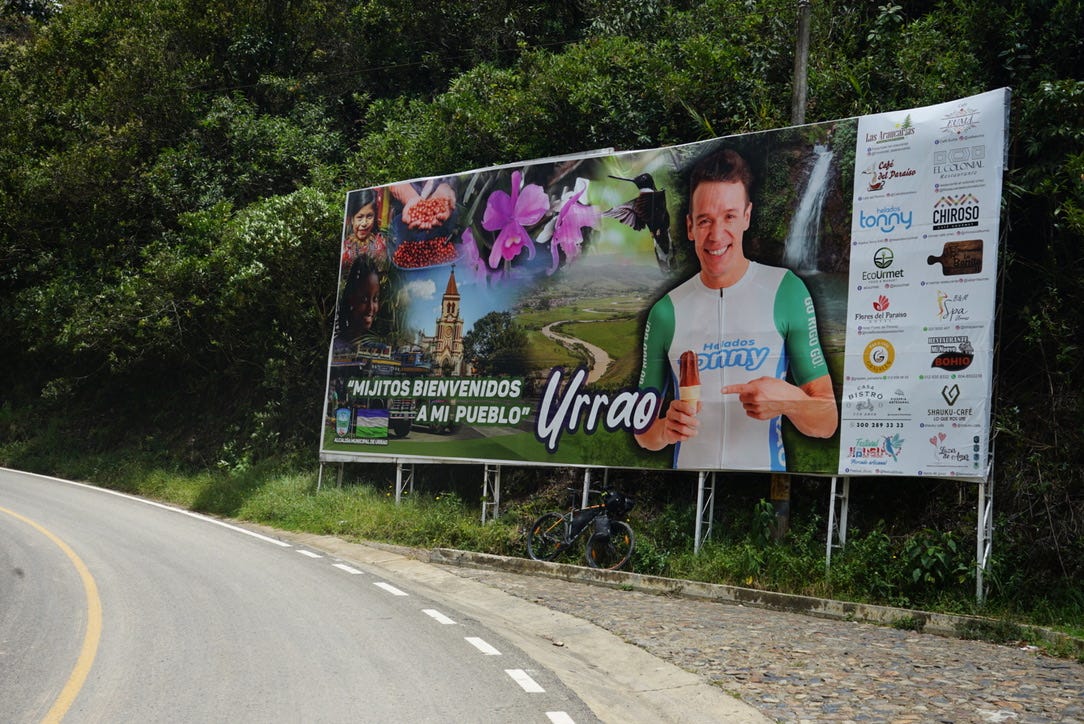Uphill Battle: The Rise and Decline of Colombian Cycling
After conquering cycling's heights, Colombia is losing ground. Late last year, OffMap Media went to cycling cradle Urrao to find out why.

I am riding my mountain bike on smooth pavement that runs over a plateau along a meandering river. I am trying to keep up with the Rigoberto Uran Cycling Club: a dozen teenagers on much lighter road bikes.
Almost every day, these boys from the town of Urrao gather to ride, train, and race in Colombia’s Western Andes. The vibe is relaxed, amicable. While most are here for fun, one kid is dead serious. Jhohan, inspired by the club’s namesake, wants to become Colombia's next best cyclist.
This article was written by Douwe den Held from OffMap Media and is shared with the Sports and Crime Briefing with his kind permission. Douwe den Held and Anastasia Austin are two of the finest journalists in Latin America, cycling their way to the most fascinating locales in the continent and telling the stories of those they meet along the way.
The odds are against him. While his fellow riders wear cycling shoes, he wears sneakers. While they ride on aluminum bikes, he barely keeps up on a much heavier, rusty steel hand-me-down from his uncle. While the rest of the team has just come from school, Jhohan -- who’s 17 -- has just finished a grueling day working in construction.
Yet, he wouldn’t be the first cyclist from Urrao to beat the odds. Colombian cyclists have always punched above their weight.
To succeed, the country’s cycling talent has had to navigate a landscape of poverty, armed conflict, road dangers, and a systemic lack of professionalism in local, regional, and national cycling infrastructure.
Nevertheless, a golden generation of Colombians conquered the sport's greatest heights, culminating in Nairo Quintana’s wins of the Giro d’Italia in 2014 and the Vuelta a España in 2016, and Egan Bernal's historic victory at the 2019 Tour de France—cycling's most prestigious race. In a sport dominated by Western countries, Colombia is the only non-Western nation to break into the top ten.
But in recent years, the country has rolled past its peak. Its wins on the WorldTour, cycling’s highest level, have steadily declined from 50 in 2018 to only 12 in 2024.
What’s more, few new riders have joined the ranks. On average, Colombia’s riders are almost 28 years old -- the age at which most cyclists peak. Of its 13 WorldTour cyclists, only two are under 25 -- not enough new blood.
I went to Urrao, a cradle for cycling champions, to understand what’s driving Colombia’s decline – and what made its cyclists so successful in the first place, despite the odds.
The Cycling Cradle
In many ways, Urrao is a bustling town like so many in Colombia. Its central square is bordered by little coffee shops and restaurants on all sides, and it fills up on weekends when people from the countryside come to buy, sell, meet friends, and drink.
It’s here that I meet Jorge Flores and Enrique Serna in a hole-in-the-wall coffee shop. We take a table outside to people-watch while we talk and sip our tintos. Both are part of the cycling “old guard.” They’ve witnessed some of the world’s best cyclists come up through the local club while they were on the board.
Cycling culture is strong in Urrao: aside from the club, the town has multiple bike shops and weekly group rides. Though home to just 17,000, it has had an outsized impact on the sport.
Part of the reason is geography. Unlike nearby towns surrounded exclusively by steep, grueling climbs, Urrao’s terrain is relatively flat, sitting as it does on a plateau at 1,800 meters. This landscape makes cycling accessible – it's a practical form of transportation for locals. Yet, the town’s high altitude and surroundings also make it an ideal training ground for those seeking a challenge.
Urrao is also a frontier town. To the east lies an immense, impassable jungle stretching to the Pacific Ocean. This isolation means the town’s main road -- though paved -- sees little traffic, a rarity in a country where most roads are unpaved and poorly maintained.
Flores and Serna start by telling me about the rich cycling history.
Oscar Jesús de Vargas was the first cyclist from Urrao to break through to the highest level. He finished third in the 1989 Vuelta a España. Others followed, like Luis Felipe Laverde, who won two stages at the Giro d’Italia between 2002 and 2008.
Rigoberto ‘Rigo’ Uran definitively put Urrao on the map. Not only because of his achievements -- during his near 20-year career, he has claimed second place in the Tour de France, the Giro d’Italia, and the 2012 Olympic Games in London -- but also for his irreverent personality. In a sport that sometimes takes itself too seriously, Rigo is famous for dancing, making jokes, and swearing on live TV to lighten the mood.
Rigo’s Rise
Rigo’s road to the top was far from easy.
For decades, Colombia’s armed conflict cast a long shadow over Urrao. From the 1980s onwards, left-wing guerrillas controlled its rural areas. Violence escalated when right-wing paramilitaries arrived in 1997.
Rigo’s father registered him with Urrao’s cycling club in 2001, at a time when the town was caught in the middle of the war.
Shortly after, Urrao started making global headlines – and not in a good way. Guerillas kidnapped Guillermo Gaviria, governor of the department of Antioquia, while he was leading a peace march near Urrao. They brought Gaviria to a camp in rural Urrao, held him prisoner for over a year, and executed him when the army dared to send in a rescue mission.
Travel in and out of the town – or cycling for that matter – was dangerous during this dark period. Flores remembers being stopped at four checkpoints on a single trip to the next town over: by the army, police, paramilitaries, and guerrillas, each accusing him of collaborating with the enemy.
“You didn’t know who to obey,” he told me about the armed groups, looking out over the square. “Both sides could kill you.”
Just months after young Rigo first picked up a bike, paramilitaries killed his father at a checkpoint on baseless accusations of collaboration with the guerillas.
The brutal act not only left Rigo fatherless at 14 years old, it also made him the family’s breadwinner, taking over his father’s job of selling lottery tickets. Overnight, cycling became more than a passion – it became a potential lifeline from poverty.
The cards were stacked against him. Aside from having just lost his father and having to work, Rigo started on poor equipment. “He had a monareta—a basic bike with a little basket on the front,” Alexander Pino, a childhood friend and neighbor, tells me. “ That’s what he started training on.”
Yet, Rigo’s talent shone through. “Every Saturday, we held informal races, and Rigo won his first one right away,” Flores recalls.
Just two years later, Rigo joined Orgullo Paisa, a pro-team in Medellín, Colombia’s second biggest city. Within three years, the Italian team, Tenax, signed 19-year-old Rigo. He went on to ride on the highest level for almost two decades, winning stages in all three Grand Tours.
“People know Urrao because of Rigo,” Flores says.
In Colombia, people don’t just know Rigo. He is a demi-god. People recognize themselves in him, the eternal number two.
The 2023 telenovela “Rigo” -- which has a run time of about 75 hours -- eternalized the cyclist, telling his story in 99 episodes.
Even before retiring from the WorldTour level, he parlayed his well-known persona into one of the best recognized brands in Colombia – “go-rigo-go” – which sells everything from bikes and parts, to clothes, to a special line of candy.
He’s also an advertising mainstay. Look at a billboard or commercial in Colombia, and there is a big chance Rigo appears promoting anything, from telecom providers to mattresses.
Since retiring at the end of last year, he has focused even more on expanding his empire which also includes “Rigo” restaurants, luxury boutique hotels, and the biggest annual amateur cycling race on the continent.
No wonder that for youths like Jhohan, Rigo personifies the Colombian dream of success. But the old guard has doubts that the new generation can reach the same heights.
“Rigo worked incredibly hard,” says Serna. “Nowadays the younger generation…They don’t have the discipline that Rigo had.”
Breaking Down the Myth
It wasn’t just discipline and talent though. Many of those who came up with Rigo had equal raw talent, according to Urrao’s veterans who watched the cyclist shoot to stardom. Yet, few made it out of Urrao, let alone to the Grand Tours in Europe.
Over the days I spend in Urrao, Flores and others of the town’s cycling old guard tell me countless tragic stories. There was one kid, even more talented than Rigo, who got killed after getting involved in drug sales in Medellín. Another – Luis Felipe’s brother Juan David – joined Orgullo Paisa with Rigo and had a promising career that ended when he was hit by a truck. There were scores more, forced to put away the bike by the harsh realities of growing up in rural Colombia.
“At 16 or 17, kids here have to start earning money. They can’t live off cycling, so they abandon it to work. After a day on the farm, they’re too exhausted to ride,” bikeshop owner, Fernando Pino tells me.

Comparing their stories to Rigo’s demonstrates a core truth: to have made it in Colombian cycling, you also needed plenty of luck and a community’s support.
Rigo had both in spades.
He benefited from the small kindnesses of neighbors. “For instance, at the shop where cyclists gathered to train, they’d give Rigo his breakfast, his coffee,” Alexander Pino tells me.
He was also lucky to come up when the local government supported cycling.
“When Rigo was in the club, we had a mayor who invested in us,” Flores explains.
“The municipality paid for a technician, covered race travel costs, and enabled us to organize departmental races.”
And he benefited from the experience of those who came before him. Marlon Pérez, who had already raced for European teams, helped Rigo to secure his first spot with a team in Italy.
A Widening Gap
Since Rigo, Urrao has not produced a new WorldTour cyclist. Beyond discipline and strength, the new generation does not have the support that helped Rigo succeed.
Jhohan, the kid I met during the training with the Rigoberto Uran cycling club, surely has the determination. And he may have the talent – that will become clearer as he starts racing.
But his dream – the Colombian cycling dream, which says that you can make it on a rusty bicycle if you work hard enough – is less likely to come true than ever.
In Urrao, the municipality contributes less to cycling than it did in Rigo’s days.
Currently, municipal support is limited to paying a trainer for the cycling club, Mauricio Montoya, the town’s Sports Secretary, tells me. He says that the smaller investment is in line with the administration’s goal of broad participation which sees a limited budget spread across 16 sports.
“We want as many kids as possible to participate. While it’s great if some reach the highest level, our goal is not so much to create great cyclists, but great people,” he says.
This less cycling-focused approach means that if young cyclists want to participate in the races crucial for their development, their parents need to chip in.
This lack of government investment exists at all levels, not just locally. Colombian riders have long criticized the national cycling federation for its minimal support of young talents. This problem, already present during Rigo's rise, has worsened as Colombia's national government continues to cut cycling funding.
This year, the federation cancelled the Tour de Colombia, one of the country's few professional races—eliminating a valuable opportunity for the new generation to showcase their abilities to the world.
The lack of support widens the gap between Colombian talent and their peers in Western countries, for whom access to sophisticated training and nutrition programs, as well as technology, is a given. These trickle down to small, isolated Colombian towns much later, if at all.
Nairo Quintana and Egan Bernal recently echoed this in a podcast, emphasizing the need for better preparation and training to compete with Western nations.
Without significant investment in infrastructure, training, and youth development, the next golden generation may never emerge.
Back on Urrao’s central square, Flores tells me, “we had a theory here in Urrao, that great cyclists are harvested every 3 to 4 years.”
That harvest has, for now, dried up.







